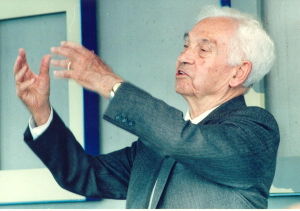Ernst Mayr
Ernst Walter Mayr (1904-2005), was an American ornithologist and theoretical biologist based at Harvard University.
Born in Bavaria to an upper middle class family with a medical tradition, he took his PhD with ornithologist Erwin Stresemann at the University of Berlin in 1925. His first collecting expedition took him to New Guinea in the Dutch East Indies, now Indonesia. Over his career he named 26 new species of bird and 38 new species of orchid. From 1931 to 1951 he worked at the American Museum of Natural History in New York. In 1951 he became Louis Alexander Agassiz Professor of Zoology at Harvard University; from 1961 to 1970, he also served as Director of the Harvard University Museum of Comparative Zoology. He became professor emeritus in 1975.
His major achievement, in Systematics and the Origin of Species (1942), was solving a central problem in evolutionary biology: how new species came about. He rejected the longstanding theory that species are comprised of certain characteristics. Instead, he argued that a species comprised a geographically discrete inter-breeding population. Species have many varieties, and these depend on geography; two subgroups are geographically separated they adapt differently to their respective environment and become two species, which do not interbreed.
He, along with Theodosius Dobzhansky, George Gaylord Simpson, and G. Ledyard Stebbins, founded the "Modern Synthesis" in evolutionary biology. "The Modern Synthesis sought to integrate Charles Darwin's theory of natural selection with the recent development of population genetics by R. A. Fisher, Sewall Wright, and J. B. S. Haldane."[1]
He wrote many books, articles and papers. After 1970 he turned to historical and philosophical issues. This is Biology: The Science of the Living World.[2] In the opening chapter, What Is the Meaning of “Life” , he declares that understanding 'life' is one of the major objectives of biology. His great history The Growth of Biological Thought: Diversity, Evolution, and Inheritance appeared in 1982.
